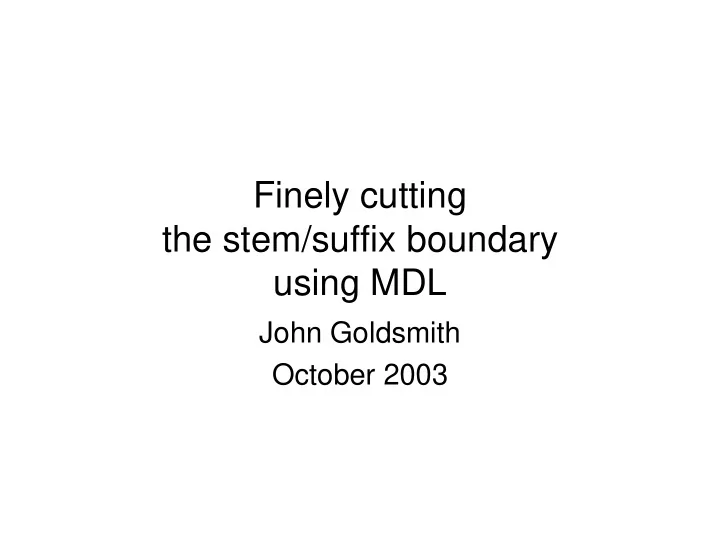

Finely cutting the stem/suffix boundary using MDL John Goldsmith October 2003
Starting point… • Familiarity with information theory – Information complexity of referring to an entity X is –log freq X • Unsupervised learning of grammar…and in particular, of natural language morphology
• MDL Minimum Description Length – Goal of analysis is to maximize the probability of the data – Prob (data) = prob (data|model)*prob(model) – Prior probability distribution over models exponential in the length of the model in its minimal formulation
• MDL Minimum Description Length – …Prior probability distribution over models exponential in the length of the model in its minimal formulation – So minimize the sum: • log probability of data + length of model • Can linguists seriously use the notion of length of a grammar ? (Householder 1965, Chomsky and Halle 1965)
That’s what we’ll show…do. • The Zellig Harris successor frequency suffix-finding bootstrapping algorithm is good, but far from perfect. • Can MDL catch its errors?
Some errors on 250K words • on & ve: – affirmati agressi attenti comprehensi conclusi decisi destructi evasi …15 more • l & tion: – differentia inaugura • NULL & rs – ringside teenage • ous & ty – tenaci vivaci • e & y > le & le > ble & bly – admirabl audibl conceivabl considerabl equitabl formidabl honorabl impeccabl impossibl incomparabl incredibl indelibl irredeemabl justifiabl notabl predictabl preferabl reasonabl remarkabl terribl unavoidabl (4 more)
Let us consider each signature σ • And evaluate its description length; • Then consider slicing each of its words 1,2,3, or 4 letters further to the left. • We compute the grammar length of the signature(s) in each case, and choose the one with the smallest DL.
DL of a signature σ • Sum of: 1. The description length of each stem in the signature (actual phonological substance) 2. The description length of the pointer to the suffix in the signature 3. The (prorated) portion of the phonological substance of the suffix 4. The length of all of the pointers to that signature σ found on each of its stems
ed.ing.s • With stems jump, walk – Length of jump : 4 log(26) • Length of pointer to –ed : -log freq (ed) = − # words ending in ed − log # analyzed words in corpus
Entropy of the ends of the stems • Measure how much variety there is among the last 1 (or 2,3,4) letters of the stems • If there’s too much variety (= entropy), it’s unlikely that the varying material ought to be in the suffixes. • Entropy threshold : 1.5
stem entropy for on.ve Shift # letters: 1: Entropy sufficiently small: 0 Shift # letters: 2: Entropy sufficiently small: 0.987693 (why?) Shift # letters: 3: Entropy too large: 3.23619 (Threshold 1.5.) Shift # letters: 4: Entropy too large: 4.26269 (Threshold 1.5.)
suffix use by this signature: +on use count: 26 DL: 7.685 Information for this suffix is owned by this sig in this proportion: 0.885 ; i.e. 8.316 bits +ve use count: 23 DL: 7.862 Information for this suffix is owned by this sig in this proportion: 1.000 ; i.e. 9.401 bits
By the way… This information is generated automatically by Linguistica when you turn on its log.
Length of pointers to this sig: 180.833 Current signature's DL: 214.098
Entropy tells us to consider moving 1 or 2 letters to the right affirma “ti” cases... atten co-opera destruc imagina introspec posi provoca recep representa
tion and tive tion existed; old count was 15; New DL for this affix: 7.138 tive did not exist before; DL for this affix is 26.664 26.664 is a lot bigger, because this signature would have to pay for all of the new suffix.
• Pointers to this sig: 80.639 • That’s 10 times 8.0639 – one pointer for each of its stems. • Total for this signature: 114.441bits
Now, sion and sive sion did not exist before; DL for this affix is 26.664 sive did not exist before; DL for this affix is 26.664 aggres “ si” cases comprehen conclu deci eva exclu expan explo indeci percus permis persua repres
sion.sive Pointers to this sig: 99.910 Total for this sig: 153.239 So total for tion.tive and sion.sive: 267.680 compared to the original 214.098 That’s a loser…
Let’s add one letter to the suffixes New signature: ion.ive • ion existed; old count was 85; New DL for this affix: 5.631 • ive existed; old count was 5; New DL for this affix: 7.579 Nice!
New stems… affirmat imaginat aggress indecis attent introspect co-operat percuss comprehens permiss conclus persuas decis posit destruct provocat evas recept exclus representat expans repress explos
Pointers to this sig: 157.833 Total for this sig: 171.042 That’s better than the original, which was 214.098
We’ve left out so far stem-content information • There are two aspects of this: – As you shift material from the stems, each of them is shorter, and hence has a smaller information content; • And if the new stem that is created is one that exists independently, then the new signature is responsible for only part of it, not all of it. Both of these are important considerations.
Recommend
More recommend